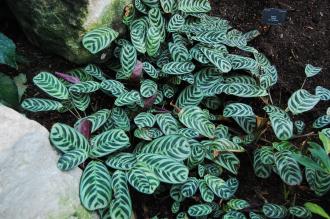
Ctenanthe burle-marxii (16/01/2016, Kew Gardens, London)
Position: Indirect bright to medium light
Flowering period: All year round
Soil: Moist, well drained
Eventual Height: 30cm
Eventual Spread: 50cm
Hardiness: 10a, 10b, 11, 12, 13
Family: Marantaceae
Ctenanthe burle-marxii is an evergreen perennial with a clump forming habit. Its striped dark green and grey/ green leaves are purple on their undersides, oblong ovate with entire margins, up t0 25cm long and 10cm across. Its white flowers are borne on short spikes.
Ctenanthe burle-marxii, commonly known as Fishbone Prayer Plant, Burle Marx Ctenanthe or Never Never Plant, is native to south Central America to south east Brazil. In its native habitat it grows as a tropical woodland understory plant.
The etymological root of the binomial name Ctenanthe is derived from the Greek ktenos meaning ‘comb’ and anthera menaing ‘anther’. Burle-marxii is named after the landscape architect Roberto Burle-Marx (1909 – 1994), who discovered this plant.
The landscape architect may find Ctenanthe burle-marxii useful as an attractive foliage houseplant suitable for bright conditions. It is also suitable for atrium planting as an effective ground cover plant.

Ctenanthe burle-marxii Leaf (16/01/2016, Kew Gardens, London)
Ecologically, Ctenanthe burle-marxii is of little value to UK wildlife.
Ctenanthe burle-marxii prefers moist, humus rich, well-drained soils. It tolerates most pH of soil.
When maintaining Ctenanthe burle-marxii as a houseplant its soil should be watered regularly. Watering should be reduced during the winter months. Its preferred active growing temperature rages from between 18ºc to 24ºc, although it will tolerate a winter temperature as low as 14ºc. Feeding with weak fertiliser solution should be carried out once every two weeks during the growing season. This plant may be sprayed to improve humidity. Red Spider Mite and Mealy Bugs may attack this plant.

Landscape Architecture

